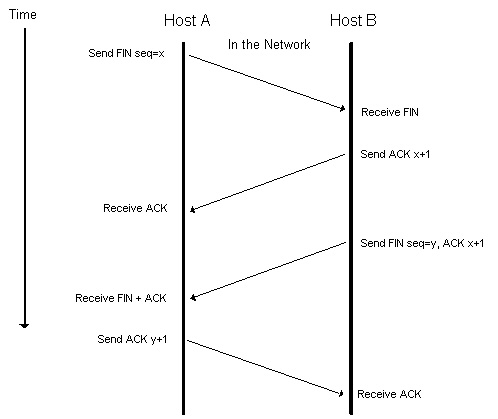TCP data transmission
Connection Establishment and Termination
TCP provides a connection-oriented service over packet switched networks. Connection-oriented implies that there is a virtual connection between two endpoints.3 There are three phases in any virtual connection. These are the connection establishment, data transfer and connection termination phases.
2.1 Three-Way Handshake
Connection Establishment
In order for two hosts to communicate using TCP they must first establish a connection by exchanging messages in what is known as the three-way handshake. The diagram below depicts the process of the three-way handshake.

Host A initiates the connection by sending a TCP segment with the SYN control bit set and an initial sequence number (ISN) we represent as the variable x in the sequence number field.
At some moment later in time, Host B receives this SYN segment, processes it and responds with a TCP segment of its own. The response from Host B contains the SYN control bit set and its own ISN represented as variable y. Host B also sets the ACK control bit to indicate the next expected byte from Host A should contain data starting with sequence number x+1.
When Host A receives Host B's ISN and ACK, it finishes the connection establishment phase by sending a final acknowledgement segment to Host B. In this case, Host A sets the ACK control bit and indicates the next expected byte from Host B by placing acknowledgement number y+1 in the acknowledgement field.
Data Transfer
Once ISNs have been exchanged, communicating applications can transmit data between each other. A simple TCP implementation will place segments into the network for a receiver as long as there is data to send and as long as the sender does not exceed the window advertised by the receiver. As the receiver accepts and processes TCP segments, it sends back positive acknowledgements, indicating where in the byte stream it is. These acknowledgements also contain the "window" which determines how many bytes the receiver is currently willing to accept. If data is duplicated or lost, a "hole" may exist in the byte stream. A receiver will continue to acknowledge the most current contiguous place in the byte stream it has accepted.
If there is no data to send, the sending TCP will simply sit idly by waiting for the application to put data into the byte stream or to receive data from the other end of the connection.
If data queued by the sender reaches a point where data sent will exceed the receiver's advertised window size, the sender must halt transmission and wait for further acknowledgements and an advertised window size that is greater than zero before resuming.
Timers are used to avoid deadlock and unresponsive connections. Delayed transmissions are used to make more efficient use of network bandwidth by sending larger "chunks" of data at once rather than in smaller individual pieces.
Connection Termination
In order for a connection to be released, four segments are required to completely close a connection. Four segments are necessary due to the fact that TCP is a full-duplex protocol, meaning that each end must shut down independently.
TCP Connection Termination

Notice that instead of SYN control bit fields, the connection termination phase uses the FIN control bit fields to signal the close of a connection.
To terminate the connection, the application running on Host A signals TCP to close the connection. This generates the first FIN segment from Host A to Host B. When Host B receives the initial FIN segment, it immediately acknowledges the segment and notifies its destination application of the termination request. Once the application on Host B also decides to shut down the connection, it then sends its own FIN segment, which Host A will process and respond with an acknowledgement.